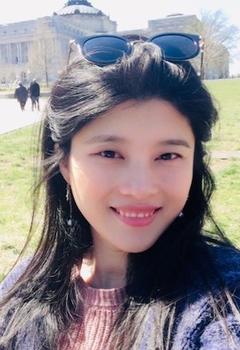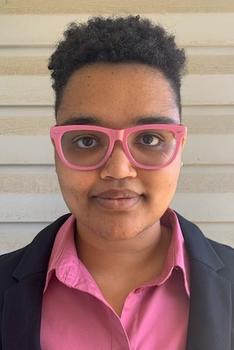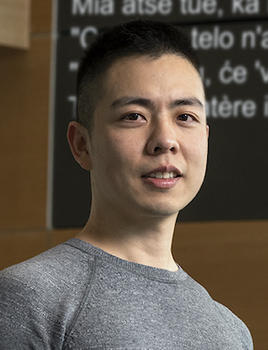Karen T. Lee said she really likes conferences.
The assistant director for George Mason University’s Office of Student Scholarship, Creative Activities, and Research (OSCAR) especially likes the National Conference on Undergraduate Research.
That is where undergraduate students from across the country showcase their research to their peers and their mentors, network, and meet with graduate school representatives.
Even though this year’s event, April 4-8, is again virtual, Lee said the impact is just the same.
“It’s a way for students to see what other students in their field are doing,” she said. “This is a possibility to meet people who might be lifelong colleagues, and undergraduate conferences are often the best places to get that opportunity.”
Fifteen Mason students will make presentations at the event. Lee said having one’s research accepted by the conference review board is high praise.
“In a typical year there are several thousand presentations,” Lee said. “For a student to be accepted, it means their research was judged to be significant, well thought-out, and interesting from a disciplinary perspective; not only well put together, but something people would want to know about.”
Here is some of the research to be shared by Mason students:

Lin Grodi
Senior, Human Development and Family Science
Teacher-Family Communication among Latinx Immigrant Families and Teachers of Young Latinx children during COVID-19
The research: Grodi said the overarching focus of her study is family engagement. She examined teacher-family communication during the pandemic among Latinx immigrant parents and teachers whose students’ parents were immigrants of Latinx descent.
Why the research is important: According to Grodi’s research, the nature of online learning provided teachers a wider window to better understand students and families. Moving forward, technology can continue to play an important role in supporting ongoing communication between parents and teachers. Interpreters are essential in breaking down language barriers, so that parents can be invited as partners into their children’s education. Grodi said that this is even more significant for communication and relationships across parents and teachers from different cultural backgrounds.
Quotable: “The findings from Lin's project provide important insight for the early childhood field in terms of how we might build on the momentum of the lessons learned during the pandemic to further support families and teachers in building reciprocal relationships through two-way communication," said Colleen Vesely, associate professor in the College of Education and Human Development, who served as Grodi’s mentor.
—Lauren Reuscher

Molly Izer
Sophomore, Government and International Politics
Misinformation Gone Viral: How Paywalls Impact the Consumption of Misinformation
The research: Izer is studying where people go after they hit a paywall when looking online for credible information and news. “There’s a critical gap between when people hit a paywall versus where they find information after all,” said Izer, an Honors College student who has interned in the U.S. Senate and House of Representatives.
Izer said she is surveying a randomized group on their information consumption habits, personality, political orientation, and demographics. She’s also gathering quantitative data from observing additional participants as they live-react to finding information and reaching a paywall.
Why the research is important: “As society becomes more and more heavily digitized, we’re seeing society becoming more hyper partisan,” Izer said. “Getting to know online journalism, paywalls, and the consumption of misinformation will allow us to better legislate around that issue and better understand how we can make an informed civil society.”
Quotable: “Molly is ambitious, tenacious, and courageous,” said Associate Professor Jennifer N. Victor. “She performs and operates on campus more like a graduate student than a first-year student. She is an excellent class participant, strives to meet her personal and academic commitments ahead of schedule, and is helpful to her peers.”
—Mariam Aburdeineh

Tulane Simpson
Senior, English
Ecoandrogyny: Examining Environmentalism Beyond the Gender Binary
The research: Simpson said they wanted to study how to make environmentalism more gender neutral. Their research examines how important gender has historically been in shaping how people think about the environment, with, for example, women traditionally being cast as eco-caretakers and men traditionally being cast in opposition to nature.
Simpson used “Avatar: The Last Airbender,” a children’s animation show, as a case study in leveraging individual gender expression for environmental goals.
Why the research is important: Jessica Hurley, assistant professor of English who helped supervise Simpson’s research, said, “The project is about giving people the freedom to decide how they want to fight for environmental justice without being limited by gender roles and expectations.” Simpson’s work also will be displayed in a virtual presentation of “Posters on the Hill,” which showcases student research to members of Congress.
Quotable: “In any television show, having more representation is a good thing,” Simpson said. “If a show has the goal of encouraging environmentalism, it should portray different gender expressions to appeal to people more broadly.”
—Anna Stolley Persky

Ruoyu Xie
Senior, Computer Science
Bilingual alignment for optical character recognition text
The research: Xie is exploring natural language processing, a form of artificial intelligence in which computers can learn, understand, and respond to text or speech. Xie is applying this to the endangered language of Griko, a Greek variety spoken by about 60,000 to 70,000 people in southern Italy. By using books in which Griko and standard Italian are displayed side-by-side as the software data, Xie is providing the computer a tutorial from which to translate between Griko and Italian.
Why the research is important: There are more than 7,000 distinct languages across the globe, according to Ethnologue, with about 3,000 in danger of becoming extinct because of lack of use. By using optical character recognition systems to digitize the endangered language into machine-readable text, and software that ties words in an endangered language to words spoken in a widely used language, Xie says a computer can “learn” the endangered language. That will make it available for web translations and help linguists and communities document these languages. As Antonios Anastasopoulos, an assistant professor of computer science and Xie’s mentor, said, “We’re running out of time.”
Quotable: “Language is one of the representations of a culture,” Xie said. “So you can say, ‘Yes, languages come and go.’ But if we forget about a language, we forget about the culture as well.”
—Damian Cristodero
